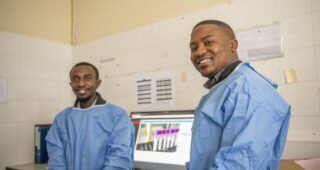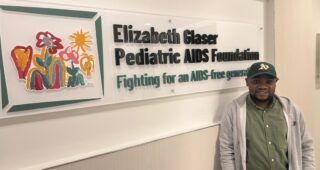Treatment for Life, Part 4: Living Positively

Nteboheleng is a 29 year old soft-spoken woman with a round face and brilliant smile. She lives in Mafeteng, Lesotho, works in local textile factory, and is currently studying part-time in hopes of getting a higher-paying job.
Nteboheleng is eight months pregnant with her second child. She waited until she was five months along to attend her first prenatal visit—much longer than recommended. Her delay was caused by a fear that she may be HIV-positive. The suspicious behavior of a past partner made her nervous that she had contracted the virus.
“I was afraid of the psychological stress of learning my status,” she says. “But one day I told myself that I have to face this. I have to go.”
Nteboheleng went for a prenatal visit at the maternal and child health (MCH) clinic at Mafeteng Hospital and received an HIV test. She tested positive.
Option B+: A Lifelong Treatment Plan Focused on the Mother
Nteboheleng was initiated that day on Option B+, an antiretroviral treatment (ART) plan that will protect her and her unborn child during pregnancy, childbirth, breastfeeding, and throughout the course of her life.
In April 2013, Lesotho’s Ministry of Health, with assistance from the Elizabeth Glaser Pediatric AIDS Foundation (EGPAF) and partners, adopted Option B+. The new guidelines were designed to optimize prevention of mother-to-child transmission of HIV (PMTCT) by recommending all pregnant or breastfeeding women who test HIV-positive be immediately enrolled on ART and remain on treatment for life.
EGPAF helped to implement these guidelines in all supported health facilities through the Strengthening Clinical Services Project (SCS) project, which was funded by United States Agency for International Development (USAID) from 2010-2015.
Previously, pregnant women who tested HIV-positive underwent viral load testing (determined by CD4 count). Women with CD4 counts below 350 were enrolled on lifelong ART. Women with CD4 counts above 350 received a temporary drug regime, designed specifically to protect their baby during pregnancy, childbirth and breastfeeding; the regimen was not available to women once the breastfeeding period ended.
This system was complicated. Health workers were tasked with ensuring every woman who tested positive returned several times for various CD4 tests and prescribing the correct treatment protocols. Those women had to follow complicated diagnostic steps—on top of coping with the shock of an HIV-positive test result.
As a co-chair of Lesotho’s PMTCT technical working group, EGPAF played a large role in the transition, providing technical assistance to the Ministry of Health to create new guidelines, translating those guidelines into training materials, and rolling out the training materials at health facilities nationwide.
When a pregnant woman comes to a health clinic and tests positive for HIV, she is now immediately enrolled on lifelong treatment, as Nteboheleng was, regardless of her CD4 count.
“Option B+ optimizes the mother’s health while protecting the baby,” says EGPAF country director Appolinaire Tiam, M.D. “I love it. The focus is no longer just on the baby; the focus is also on the mother.”
Today Nteboheleng is feeling optimistic about her future. “I am now okay with my status,” she says. “I thought when I learned I was HIV-positive that I was going to get sick. But I am now stronger than before. Getting into treatment before I got sick…I really appreciate that.”
Read, "Treatment for Life, Part 3: 'This Policy Brings Life to the Next Generation.'" here.
Read, "Treatment for Life, Part 2: Option B+: Working Toward a Generation Free of HIV," here.
Read "Treatment for Life, Part 1: Option B+ Gives Mothers and Children Options," here.
Heather Mason and Rachel Samdahl
General



